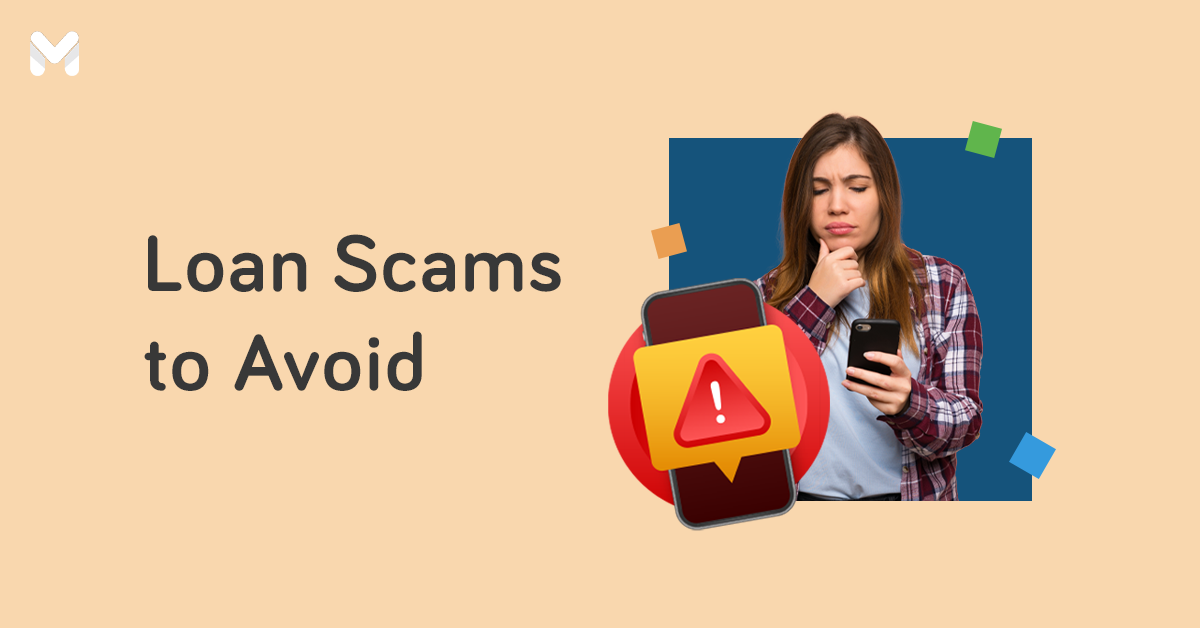From car breakdowns and a family member getting sick to typhoons and sudden unemployment, you’ll never know when a financial emergency will happen. And even if you prepared beforehand, you may find that your measures are not enough.
Thankfully, you can always turn to emergency loans in the Philippines. Loans of this type offer quick cash when you need to deal with an unexpected expense right away.
But just because you need quick cash doesn’t mean you’ll pick the first lender that will come your way. You need to understand both the benefits and risks of each loan option, so repayment won’t be difficult.
Here’s how to get an emergency loan in the Philippines:
Emergency Loans in the Philippines: 5 Ways to Borrow for Urgent Cash Needs
Emergency loans in the Philippines come in different types. Here are some of them, including their loan amounts, interest rates, pros, and cons:
Option 1: Personal Loans from Banks

If you need a big amount, apply for a personal loan. It's a safe, legitimate, and affordable way to borrow money in the Philippines, thanks to low interest rates and long repayment terms.
Note, however, that banks have strict loan requirements and credit investigation processes for borrowers. Compared to other lenders, providers also take longer to process applications—typically three to seven days, or sometimes longer—to assess a borrower's ability to repay a loan.
👍 Advantages of Personal Loans
- Higher loan amounts
- Safer, more legitimate, and more affordable way to borrow money than informal loans
- Low and fixed interest rates
- Longer repayment terms than those of informal lenders
👎 Disadvantages of Personal Loans
- Longer processing time for most banks
- More stringent application process than private lenders
- Issued based on credit, so those with low credit scores may not qualify
If you’re looking for a reputable bank to lend you money, here are your top options, including their loan amount, interest rate, loan terms, required minimum annual income, and approval time:
|
Provider
|
Loan Amount
|
Monthly Add-on Rate
|
Loan Term
|
Minimum Annual Income
|
Approval Time
|
|---|---|---|---|---|---|
|
UnionBank Personal Loan
|
Up to ₱2 million
|
26.9% per annum
|
12 to 60 months
|
₱250,000
|
As fast as 5 minutes
|
|
UNO Digital Bank Personal Loan
.png?width=149&height=52&name=Unobank-Logo-Colored_Horizontal-Medium%20(for%20MMX).png) |
₱10,000 to ₱500,000
|
1.79% per month (corresponds to annual contractual rates or annual percentage rates ranging from 35.78% to 37.54%)
|
Six to 36 months
|
₱240,000
|
Five to seven banking days
|
|
Metrobank Personal Loan
|
₱20,000 to ₱2 million
|
1.25% to 1.75%
|
36 months
|
₱350,000
|
Seven banking days
|
|
BPI Personal Loan
 |
₱20,000 to ₱3 million
|
Maximum annual contractual rate of 28.67%
|
12 to 36 months
|
Inquire with BPI
|
Five to seven banking days
|
|
Tonik Credit Builder
 |
₱5,000 to ₱20,000
|
4.84%
|
Six to 12 months
|
Inquire with Tonik
|
Two banking days
|
|
Tala

|
₱1,000 to ₱25,000
|
0.43% daily
|
Up to 61 days
|
None
|
Five minutes to 24 hours
|
|
HSBC Personal Loan
|
₱30,000 to ₱500,000
|
0.65%
|
Six to 36 months
|
₱168,000
|
Five to seven banking days
|
|
CIMB Personal Loan
|
₱30,000 to ₱1 million
|
As low as 0.83%
|
12 to 60 months
|
₱180,000
|
One to two banking days
|
|
Maybank Personal Loan
|
Up to ₱1 million
|
1.3%
|
Up to 36 months
|
₱300,000
|
Inquire with Maybank
|
|
RCBC Bank Personal Loan
 |
₱50,000 to ₱1 million
|
1.3%
|
Six to 36 months
|
₱360,000
|
5 to 7 banking days
|
|
PSBank Personal Loan
 |
₱20,000 to ₱250,000
|
|
24 or 36 months
|
₱180,000
|
Five to nine banking days
|
See other personal loan guides:
- Fast and Easy Guide to Security Bank Personal Loan Online Application
- PSBank Flexi Personal Loan: What You Need to Know Before You Apply
Option 2: Emergency Loans from Private Lenders
For emergency loans in the Philippines, private lenders usually offer the simplest application process, fastest approval, and loan disbursement. That’s because they usually don’t require a bank account.
Emergency loan applications can be filed online nowadays, after which you'll know if you're approved within five to 10 minutes. With online emergency loans, you can also receive funds on the same day or even in a matter of minutes.
Plus, online lenders don't usually require as many income documents as banks do—usually just a valid ID. They offer urgent cash loans for unemployed Filipinos and those with low income or poor credit history.
👍 Advantages of Emergency Loans from Private Lenders
- Quick and easy way to get cash
- Easy requirements
- Simple online application process
- Fast approval and loan disbursement
👎 Disadvantages of Emergency Loans from Private Lenders
- Small loan amounts
- Short repayment terms
- Generally higher interest rates
Wondering, "Where can I borrow money ASAP in the Philippines?" Check out the loan providers below. They require a few documents only and disburse loans quickly:
|
Provider / Loan Product Name
|
Loan Amount
|
Interest Rate
|
Loan Term
|
|
Maya Personal Loan
|
₱15,000 to ₱250,000
|
Monthly add-on rate as low as 0.77% (effective interest rate of 1.39% per month)
|
Six to 24 months (will be soon available in 36- and 48-month terms)
|
|
GCash GLoan
 |
₱1,000 to ₱125,000
|
1.59% to 6.99% per month
|
Five to 24 months
|
|
Cashalo Cash Loan
 |
₱1,000 to ₱9,000
|
Starts of 0.5% per day
|
Up to 90 days (essentially three months)
|
|
|
₱1,000 to ₱50,000`
|
0% for your first loan; repeat clients will be informed of the rate during the application process
|
12 months
|
|
JuanHand
|
Up to ₱25,000
|
0.2% per day
|
Up to three months
|
|
Online Loans Pilipinas
 |
₱1,000 to ₱7,000 for first-time borrowers; up to ₱30,000 for repeat borrowers with good standing
|
0% for first-time borrowers
|
61 days to 183 days
|
|
Digido
 |
₱1,000 to ₱25,000
|
0% for first-time borrowers for seven days
|
Up to 180 days
|
|
₱1,000 to ₱4,000 for first time borrowers;
up to ₱25,000 for repeat borrowers with good standing
|
As low as 0.43% per day
|
Up to 61 days
|
Option 3: Calamity Loans from Government Agencies
Looking for government loans? The SSS, GSIS, and Pag-IBIG Fund all assist survivors of natural disasters in the Philippines[2] through their respective emergency loans or calamity loans. If you live in an area officially declared under a state of calamity, you can apply for an emergency loan from one of these government offices.
Compared to private lenders, the SSS, GSIS, and Pag-IBIG Fund offer longer repayment terms and significantly lower interest rates. However, you must be an active member of these agencies with consistent contributions to qualify.
The table below shows key features of each government agency's emergency loan. For more details on how to apply for these emergency loans from Philippine government agencies, check out the table below:
|
Provider
|
Loan Amount
|
Interest Rate
|
Loan Term
|
|
GSIS
 |
Up to ₱20,000 for those without existing balances; up to ₱40,000 for those with an existing emergency loan balance
|
6% per annum
|
36 months
|
|
Pag-IBIG
 |
Up to 80% of the member's total Regular Savings
|
5.95% per annum
|
24 to 36 months
|
|
SSS
 |
One monthly salary credit (MSC)
|
10% per annum
|
24 months
|
👍 Advantages of Emergency Loans from Government Agencies
- Readily available and you have every assurance since the government is the lender
- Relatively low interest rates
- In the case of SSS, the service fee that’s worth to 1% of the loan is waived
- Longer repayment terms
👎 Disadvantages of Emergency Loans from Government Agencies
- Must be an active member to qualify to any of these loans
- Relatively low loan amount
- In the case of GSIS, it’s only available to government employees
- Loan is only offered to those in a calamity-hit area (in the case of GSIS)
- Must not have any existing loan account in default with the agency (especially in the case of GSIS and Pag-IBIG
- Strict consequences of non-payments; for instance, SSS deducts the amount of the unpaid loan from short-term or final benefits
Option 4: Emergency Loans from Employers
Some companies in the Philippines offer emergency loans to employees affected by calamities. Others provide these loans as part of their employee benefits package, which workers can avail of any time they need cash for emergencies.
👍 Advantages of Emergency Loans from Employers
- Readily available since you can access it by simply reaching out to your boss / the HR department / finance department
- The employer may not charge interest.
- No processing fees and hidden charges, meaning you’ll receive the whole loan amount
- Convenient and flexible repayments since they’ll be deducted from your succeeding paychecks
👎 Disadvantages of Emergency Loans from Employers
- Lower take-home payouts since repayments will be deducted from your succeeding paychecks
- The employer may have its own set of eligibility criteria, which may limit the loan to select employees.
Option 5: Salary Loans
Another form of emergency loan in the Philippines is the salary loan. It’s similar to emergency loans from private lenders as it also provides quick and easy access to cash online.
However, salary loans have slightly higher loan amounts and stricter application requirements, including income documents such as payslips and bank statements.
👍 Advantages of Salary Loans
- Quick and hassle-free access to cash
- Higher loan amounts than private lenders
- Some lenders don’t require collateral.
- Application happens online, depending on the lender
👎 Disadvantages of Salary Loans
- Stricter application requirements than private lenders
- Shorter repayment periods
- High interest rates offered by some lenders
If you’re looking for a salary loan provider, here are your top options:
|
Provider / Loan Product Name
|
Loan Amount
|
Interest Rate
|
Loan Term
|
|
SSS Salary Loan
 |
Up to two months’ worth of salary
|
10% per annum
|
24 months
|
|
Pag-IBIG Multi-Purpose Loan
 |
Up to 80% of the member's total Regular Savings
|
10.5% per annum
|
24 to 36 months
|
|
Cash Mart Salary Loan
|
₱3,000 to ₱150,000
|
0.06% to 0.8% per day
|
Weekly, bi-weekly, or monthly
|
|
Vidalia Salary Loan
 |
₱20,000 to ₱100,000
|
6% per month
|
Three to 12 months
|
|
Blend PH Salary Loan
 |
Equal to one month’s salary
|
1% to 3% per month
|
One to six months
|
|
BPI Salary Loan
 |
Up to ₱1 million
|
18.95% maximum annual contractual rate (ACR)
|
12 to 36 months
|
|
Asteria Salary Loan
 |
₱2,000 to ₱20,000
|
0.9% per day
|
61 days, 10 weeks, and 12 weeks
|
|
Security Bank SALAD (Salary Advance)
|
Starts at ₱5,000; the maximum amount will depend on your assigned credit limit
|
Inquire with Security Bank
|
Up to three months
|
|
Chinabank SalaryPlus Loan
 |
₱15,000 to ₱1 million
|
Inquire with China Bank
|
Up to 36 months
|
Sterling Bank of Asia AvanceCash Salary Loan |
₱10,000 to ₱50,000
|
Inquire with Sterling Bank
|
Three to six months
|
|
Sterling Bank of Asia AvancePlus Salary Loan
 |
₱10,000 to ₱250,000
|
Inquire with Sterling Bank
|
One to six months
|
Option 6: Pawning or Sangla
Like 5-6 pautang, pawn loans or sangla is a popular way to get quick cash in the Philippines. This is especially true in rural areas where pawnshops outnumber banks and ATMs. If you need a source of quick cash for emergencies, you just have to provide collateral, such as jewelry or gadgets.
No need for credit checks and income documents—just make sure your collateral is authentic and valuable. Pawnshops charge interest rates as low as 1% over a one-month term.
Note that pawning valuable items can be risky. You might not get it back if you fail to pay the amount you borrowed within the loan term.
👍 Advantages of Pawning
- No credit checks and income documents required
- Lots of pawn shops everywhere in the Philippines, even in remote areas where only a few bank branches are located
- Accepts a wide range of collateral, like jewelry, gadgets, appliances, and luxury items (bags,[3] watches, and leather goods)
👎 Disadvantages of Pawning
- Requires collateral
- Can't get back your pawned item if you default on payments
Option 7: Emergency Loans from Family and Friends
"Pautang naman. Bayaran kita sa sweldo." It's that easy to borrow money from your loved ones. Your ever-reliable tita, brother, BFF, or office teammate is just a phone call or text message away.
With this kind of emergency loan in the Philippines, there are no documents required, no collateral needed, no interest to pay, and no payment due dates to worry about. Just pay back what you owe when you can.
Of course, all that comes at a cost. Break your promise to return the amount you borrowed, and you'll easily lose their trust and the chance to borrow from them again.
As much as you can, avoid being too dependent on your loved ones. This type of emergency loan in the Philippines isn't worth all the conflict, drama, and stress that ruin relationships.
👍 Advantages of Emergency Loans from Family and Friends
- Quick cash could be just a text message or call away
- No application forms and income documents required
- Usually interest-free and flexible repayments
👎 Disadvantages of Emergency Loans from Family and Friends
- Stress and anxiety when you default on payments
- Loss of trust when you can't return the amount borrowed
- May damage relationships
Final Thoughts
Have you tried any of these options for an emergency loan in the Philippines? There's no shame in asking for financial aid when the going gets tough. As long as you hold up your end of the bargain and pay back what you owe, you'll come out of these hard times unscathed.
Before you start applying for emergency loans and personal loans, make sure you can be a responsible borrower.
Sources:











